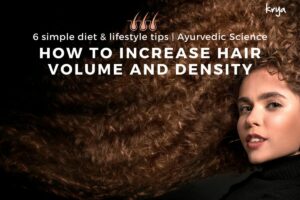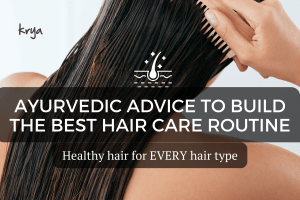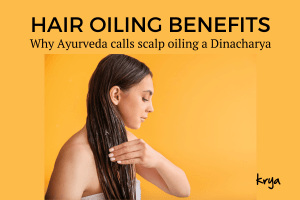This post was last updated on August 12, 2021 by Preethi Sukumaran
The Krya post yesterday shared a piece written by Dr.Anupama Santosh, an Ayurvedic vaidya at Shrestha Ayurvedic centre . In this piece she shared her concerns about herbal products and some of the issues she faces while recommending authentic natural products to her consumers.
We choose to focus on this important issue raised by Dr.Anupama in the blog today at Krya.
The modern soap and the modern shampoo find no place in the tradition of Indian skin and haircare. The traditional medicine pharmacopeia is vast, detailed and uses thousands of cleansing herbs and lists formulations that range from cures for baldness to simple hair growth.
This does not mean Indian traditional medicine is simplistic or primitive as is often assumed. Many of the discoveries and procedures described by Acharya Sushruta and Acharya Charaka (the fathers of Ayurveda) are still in use today.

For example, a facial reconstructive technique described by Acharya Sushruta 2500 years ago uses parts of the forehead and cheek to reconstruct the nose. This procedure was developed as cutting off the nose was a common punishment in that era which necessitated the development of aesthetic surgery. This technique is still in use today and is now called the “Indian Rhinoplasty technique”.
So how did mass produced soap and shampoo evolve ?
The technique for producing a basic soap is ancient. Archaeological excavations and records suggest that it was in use in Ancient Babylon 2500 years ago. The Ebers papyrus , which dates back to 1500BC, also mentions the use of soap in cleaning textiles. Again we see evidence of the use of soap in the Roman world, where it was again used to launder garments.

If you are seeing a pattern here, stay with me. We move over to Florence in medieval times where soap making has now become more evolved with the addition of perfumes distilled with knowledge brought in by the Islamic empire. Italy and France begin to compete with each other to produce finer grade soaps.
Soapmaking now reaches England. Soapmaking becomes a household art, guarded jealously by the main housekeeper of the Castle and is made in the still room.
So we have reached a point when soapmaking has become a household cottage industry. The fat trimmings from domestic meat of the animals raised for consumption would be used without wasting to be made into a cleaning soap. For the component of lye, water leached through wood ash would be used as a precursor to the commercially available Sodium Hydroxide we use. The Romans were much more economical – they simply used human urine from the public toilets, which is strong in ammonia to make Ammonium Hydroxide to make their soap.
Now here are 2 interesting facts: Soap originally started out as a textile laundering product and was generally considered extremely harsh for skin use as it was very alkaline in its pH. This alkaline nature made sense when it was used exclusively on textiles as this would help effectively cleanse out grease and dirt from wool, linen and other difficult to care for textiles.

When soap was finally adopted for personal use, it was primarily adopted by countries which experienced extreme cold and where citizens bathed very rarely.
For example, England had a day called Shrive Tuesday which fell in early summer, which was a day when the peasants would have an annual bath. For this annual bath, the lye based soap was used. Yes, your read that right – ONE bath every 365 days.
An infrequent bath was not restricted to the peasant class alone. The nobility and the monarchy in most cold countries would have a bath only once a month. The perfume industry in France itself started as a way to ward off body odour. Frequent bathing was considered an unhealthy practice and this made sense given the extreme low temperatures that could occur in these countries.
The soap and shampoo in the Modern Era:
The now ubiquitous mass produced shampoo and soap owes its origins to 3 inventors: Nicholas Leblanc, Michel Eugene Chevreul and Ernest Solvay. Their inventions in the mid 19th century, transformed what used to be a home made cottage industry based process into a multi billion dollar commercial process which spawned the commercial shampoo as well.
Why soap is not good for skin:
The modern mass produced soap is quite different from its cottage industry ancestor which used just 2 ingredients – trimmed animal fat and lye. Today, the modern soap adds other additives like talc, bleaches, fillers, colours and chemical fragrances to the mix.
However, both kinds of soaps share one common trait – they are extremely harsh on skin.

The key reason for this harsh effect on skin can be traced to a single factor – by design a soap is alkaline with a pH of atleast 8 or above. This alkaline pH makes sense if you are having a bath once a year like in Medieval England. The amount of dirt, dead cells and sebum accumulated in skin for a year would need an extremely harsh, tough cleansing product preferably with an alkaline soap.
But given our penchant for a bath atleast once a day, and often in hot water, an alkaline product like a soap alters the pH of skin. Skin’s pH has been carefully designed to be 5.5 and is kept that way by the natural oil secretions on our skin, our sweat and the presence of synergistic colonies of friendly bacteria on our skin.
When we alter the pH of our skin using a soap, this breaks this ecosystem, dries out skin, kills the friendly bacteria and leaves our skin open to the invasion of hostile bacteria. Consistent and frequent use of soap will leave skin dry, irritable and unhealthy.
(We’ve discussed much better, gentler ways to have a bath earlier.)
The issue with modern shampoos:
We have detailed the drying and scalp irritating properties of SLS in previous posts. We have spoken about how the commercial SLS laden shampoo cleans by stripping all the essential sebum from your scalp and hair. We also spoke about how this causes a counter reaction in your scalp, which then compensates with a greater amount of sebum production to make up for the lack of essential sebum.
SLS and SLeS also denatures scalp protein and damages the hair’s cuticular structure. Undamaged hair has a “hydrophobic” surface which is coated with sebum. This ensures water does not enter the hairshaft and damage hair. With the repeated use of synthetic shampoos, and harsh chemical treatments on hair like colouring and deep conditioning, this hydrophobic oily coating is rinsed away , leaving gaps in the cuticular structure through which water enters the hair shaft.
Yes I get synthetic soaps and shampoos are bad for me. What about my herbal shampoo?
Unfortunately, with the growing demand for natural products and the growing awareness for natural herbs and solutions, chemical consumer products companies have now made a clever addition to their toxin laden products.
They add, what is called in industry parlance as a “claim ingredient “ to their regular synthetic products.
The claim ingredient as per Indian law:
Unfortunately the consumer products industry – both in India & globally is very poorly regulated industry compared to say the food or pharmaceutical industries.

The first problem with “regulation” is the fact that regulation always lags or follows the introduction of a new concept. The very concept of “regulation” is new and most regulatory bodies of the 20th century were set-up by governments in response to misleading or downright false claims made by manufacturers. Think about it, the concept of a BIS standard for a soap or shampoo can be defined only after there is a significantly large industry for these products.
The second major problem is the fact that the major manufacturers are often appointed by governments as experts to set up regulations. In this regard, several shocking loopholes or low standards that favor manufactures have now been enshrined as “government standards”.

For example manufacturers can add just 1% of a ingredient say amla and claim ALL the benefits associated with it – all they have to do is use phrases likes “with the goodness of amla“ while the rest of the product could contain any manner of chemical bases or preservatives. Even organic food, a new and exciting sector , created by folks in response to pesticides & GMO has not been spared. An “organic” ready to eat food product can contain by law, preservatives like sodium benzoate. So much for “safe”, “organic” food!
Example 1:
Consumer VOICE, a leading, independent publisher did a comparative test of major Indian hair oil brands available in the market. The reference to this original article is given below. The independent study found the following in their research:
- All the brands of hair oil were based on mineral oil or Liquid Paraffin – while this was mentioned on the product label, the advertising for these products generally emphases only the goodness of the natural oils and herbs used. This test included even leading brands which claimed to be ayurvedic and natural. Light Liquid Paraffin was found to be between 62% – 91% in content. While BIS permits the use of Light Liquid Paraffin in cosmetic products, there is no maximum limit specified. This is grossly misleading as consumers are obviously buying the hair oils based on their claims of the hair oils containing vegetable oils and herbs,
- In 2 leading advertised brands of Amla (Indian gooseberry ) based hair oil, the Amla extract is less than 2%. Even with adding such a trace quantity of Amla, the Manufacturer is getting away by naming this product an Amla Hair oil, when it should really be called a Paraffin hair oil!
- A leading advertised brand of Almond hair oil contained , in fact, only a few drops of almond oil per bottle- the net weight of mineral oil was 76% and vegetable oil was over 20%.
Ayurveda has not been spared too
Unfortunately the bad habits from the chemical consumer products industry have defiled the Indian Ayurvedic sector as well. AYUSH standards from the GoI allow a range of “permitted” additives, base, preservatives etc. So you could find an “Ayurvedic” toothpaste, with one or two ingredients mentioned in the Ayurvedic texts but with the bulk of the product containing a synthetic base or with sodium lauryl sulfate as a foaming agent.
Example 2:
A leading South Indian brand of herbal hairwash powder has often been brought to our notice by Krya consumers. They check the foam generated by this herbal hairwash and tell us it is atleast twice more than the Krya hairwashes. The foam quality is also surprisingly similar to the foam generated by a synthetic shampoo – the foam is thick, and lasts for a long time on hair.
An analysis of this product’s contents proved difficult, as the Indian label lists only upto 60% of its ingredients. The natural foam generating herbs like Sapindus trifoliatus, Sapindus mukorossi (Different species of Soapberry / Reetha), and Acacia concinna (Shikakai) is less than 5%. The largest herb listed by volume is Coconut Shell powder, which has no nutritive action and is only a natural abrasive and filler.
So 2 questions you might have are: What is in the missing 40% of the product? And how is it foaming?
Both questions have one definite answer – SLS. This is not declared in the Indian pack as companies are not required by law to do so here. But SLS is listed in some of its export packs and the percentage volume is sometimes as high as 17%.The balance could possibly be made up of preservatives, other fillers, foam boosters and perhaps a fragrance – we say could, because, again the Indian law protects cosmetic manufacturers. We don’t have to disclose what goes into the products that are used so intimately by billions of consumers everyday .
Ok, dang! What are my options now?
So what is an Indian Consumer to do? If you find a product that is cheaply priced, colourful, easy-to-use, with a shelf life of more than 12 months and still “natural”, you may wonder, is this too good to be true ? Yes, indeed it is too good to be true.
Some of the points we ask our consumers to check on the label:
- Add the ingredients listed to check if they add upto a 100 % – if not ask the company what is not part of the declaration – this includes vague declarations like “base”, “q.s”, “lotion base”, etc
- Check the fragrance – if it lingers in your bathroom for a long time or on your person for a long time, it is probably not natural. Natural fragrances rarely last for long.
- Check the foam quality and consistency – synthetic foam derived from SLS / SLeS / ALeS and other chemical sources is usually extremely white, thick (think thick clouds of foam), and is retentive and substantive – so it will stay for a long time.
- Check for the mention of the words “extracts” vs. the use of whole herbs
- Check for the mention of surfactants which are described as being derived from coconuts . My favourite example is how SLS is repackaged as a natural coconut derived surfactant – My challenge back always is this – If I give you a coconut, can you make SLS for me without the use of manufacturing equipment and synthetic chemicals? If your answer is no, then stop linking this poor coconut to SLS. The coconut is as much a precursor to SLS as a real Nagpur Orange is to a synthetic orange cola.
The human body – designed for health:
Ayurveda and Siddha classical texts reveal a very wonderful fact – a normal human body is designed to live healthfully and well upto atleast 100 years of age. In fact, the texts classify middle age, as the age between 33 – 66, and old age begins only from 66 years onwards. Rasayana and rejuvenative treatments like Panchkarma are designed to internally balance the doshas and set the body back to its natural balance.

The external use of whole herb based toxin free products along with the right diet and lifestyle gives almost magical results even in decades old stubborn hair and scalp issues like dandruff, scalp flaking, hair breakage, etc.
We have chosen this August to focus on hair health and care. And to inspire your transition to natural haircare and to re-discover just how good your hair can look / be, we have a very special deal on all of Krya’s haircare products with upto 20% off on all our haircare goodies!
The Krya August Hair Olympics Challenge
To inspire a change to toxin-free natural products and to give your hair a much better shot at real health, we are celebrating the Krya Hair Olympics Challenge this August.

Looking for thicker, healthier, stronger hair this August?
Throw away your synthetic hair care products and replace them with Krya’s nourishing hair care products instead.
Every Krya hair care product for adults carries a special discount only in August 2016
- 10% off if you buy a single piece of any Krya hair care product for adults
- 20% off if you buy 2 or more pieces of any Krya hair care product for adults or a Krya hair care system for adults
Explore Krya’s huge range of good-for-you hair care products at special prices here.




